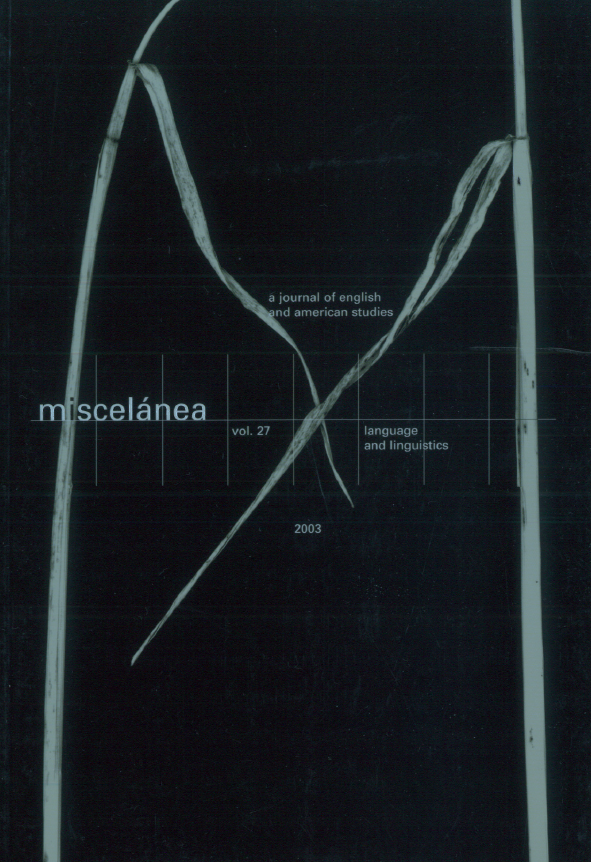Importancia de la composición de los campos semánticos en su aprendizaje
DOI:
https://doi.org/10.26754/ojs_misc/mj.200310408Palabras clave:
aprendizaje, fuerza asociativa, campo semántico, juicios de relación, instrucciónResumen
En primer lugar se tiene como propósito comprobar si en los campos semánticos Classroom/Lab. y Cognitive se produce, mediante un diseño Pretest/Posttest, aprendizaje por efecto de la variable independiente instrucción. Para ello, se van a utilizar dos tareas: un test escrito y juicios de relación y cuatro variables dependientes: prueba de traducción/definición, proximidad, distancia y similitud. En segundo lugar se comprueba en qué campo semántico se produce un mayor aprendizaje. Se explica mediante la fuerza asociativa, producida ésta por factores de composición del campo semántico: origen de los términos y grado de concreción. Resultados que están en consonancia con la teoría estructural (Bajo, Cañas, Navarro, Padilla & Puerta, 1994) y la de concreción (Harris, Tebbee & Leka, 1997; Marschark, 1992).
Descargas
Referencias
BAJO, María Teresa, José Juan CAÑAS, Raquel NAVARRO, Francisca PADILLA Y María del Carmen PUERTA. 1994. “Variables estructurales en el recuerdo de palabras concretas y abstractas”. Cognitiva, 1 (6): 93-105.
BROWN, James D. 1988. Understanding Research in Second Language Learning. Cambridge: Cambridge U. P.
COOKE, Nancy J. 1992. “Predicting Judgment Time from Measures of Psychological Proximity”. Journal of Experimental Psychology: Learning, Memory, and Cognition, 18 (3): 640-653.
COOKE, Nancy M., Francis T. DURSO Y Roger W. SCHVANEVELDT. 1986. “Recall and Measures of Memory Organization”. Journal of Experimental Psychology: Learning, Memory, and Cognition, 12 (4): 538-549.
COOKE, Nancy. M. Y James E. MCDONALD. 1986. “A Formal Methodology for Acquiring and Representing Expert Knowledge”. Proceedings of the IEEE, 74 (10): 1422-1430.
ERICSSON, K. Anders Y Neil CHARNESS. 1994. “Expert Performance. Its Structure and Acquisition”. American Psychologist, 49 (8): 725-747.
GALBRAITH, Richard C. Y Benton J. UNDERWOOD. 1973. “Perceived Frequency of Concrete and Abstract Words”. Memory and Cognition, 1: 56-60.
GOLDSMITH, Timothy E., Peder J. JOHNSON Y William H. ACTON. 1991. “Assessing Structural Knowledge”. Journal of Educational Psychology, 83 (1): 88-96.
GONZALVO, Pilar, José Juan CAÑAS Y María Teresa BAJO. 1994. “Structural Representations in Knowledge Acquisition”. Journal of Educational Psychology, 86 (4): 601-616.
HARRIS, Richard J., Michael R. TEBBEE Y Gary E. LEKA. 1997. “Bilingual and Monolingual Memory for English and Spanish Metaphors and Similes”. Póster presentado en la 38 conferencia de The Psychonomic Society, Philadelphia, Pennsylvania.
JOHNSON, Peder J., Timothy E. GOLDSMITH Y Kathleen W. TEAGUE. 1995. “Similarity, Structure, and Knowledge: A Representional Approach to Assessment”. En Nichols, Paul D., Susan F. Chipman y Robert L. Brennan. (eds.). Cognitively Diagnostic Assessment. Hillsdale, New Jersey: Lawrence Erlbaum: 221-249.
LEWIS, Norman. 1978. The New Roget’s Thesaurus. New York: Berkley. MARSCHARK, M. 1992. “Coding Processes”. En Squire, Larry R. (ed.). Encyclopedia of Learning and Memory. New York: Macmillan: 102-106.
PAIVIO, Allan, John C. YUILLE Y Stephen A. MADIGAN. 1968. “Concreteness, Imagery, and Meaningfulness Values for 925 Nouns”. Journal of Experimental Psychology Monograph Supplement, 76 (1, Pt. 2): 1-25.
PARNWELL, E. C. 1977. Oxford English Picture Dictionary. Oxford: Oxford U. P. PITARQUE, Alfonso Y Juan Carlos RUIZ. 1997. “Representación del conocimiento estructural tras el entrenamiento en esquemas procedimentales”. Psicológica, 18: 11-21.
REBER, Arthur S. 1985. The Penguin Dictionary of Psychology. London: Penguin.
SÁNCHEZ, María Jesús. 1999. “El conocimiento léxico y su aprendizaje en el inglés como lengua extranjera: aplicación del Pathfinder como método de análisis”. Tesis Doctoral. Universidad de Salamanca.
SÁNCHEZ, María Jesús. 2002. “Efecto de la instrucción con patrones lingüísticos en el aprendizaje léxico: campo semántico Shine”. Estudios Ingleses de la Universidad Complutense, 10: 182-199.
SCHVANEVELDT, Roger W. 1990. “Proximities, Networks, and Schemata”. En Schvaneveldt, Roger W. (ed.). Pathfinder Associative Networks: Studies in Knowledge Organization. Norwood, New Jersey: Ablex Publishing Corporation: 135-148.
SCHVANEVELDT, Roger W., Francis T. DURSO Y Donald W. DEARHOLT. 1989. “Network Structures in Proximity Data”. En Bower, G. (ed.). The Psychology of Learning and Motivation: Advances in Research and Theory, 24. New York: Academic Press: 249-284.
SCHVANEVELDT, R. W., Francis T. DURSO, Timothy E. GOLDSMITH, Timothy J. BREEN, Nancy M. COOKE, Richard G. TUCKER Y Joseph C. DE MAIO. 1985. “Measuring the Structure of Expertise”. International Journal of Man-Machine Studies, 23: 699-728.
SMITH, Colin. 1971. Collins Spanish-English English-Spanish Dictionary. Glasgow: Collins.
THOMPSON, Laura A., Rebecca L. GOMEZ Y Roger W. SCHVANEVELDT. 2000. “The Salience of Temporal Cues in the Developing Structure of Event Knowledge”. American Journal of Psychology, 113 (4): 591-619.
Webster’s New Collegiate Dictionary. 1980. Springfield: Merriam.
Descargas
Publicado
Número
Sección
Licencia
Derechos de autor 2003 María Jesús Sánchez

Esta obra está bajo una licencia internacional Creative Commons Atribución-NoComercial 4.0.


